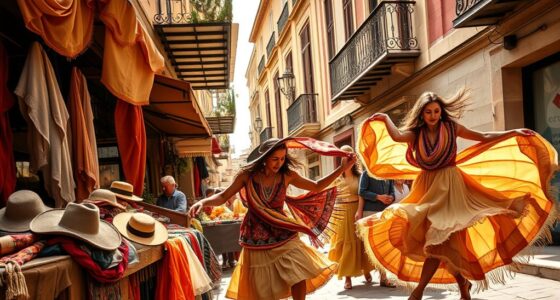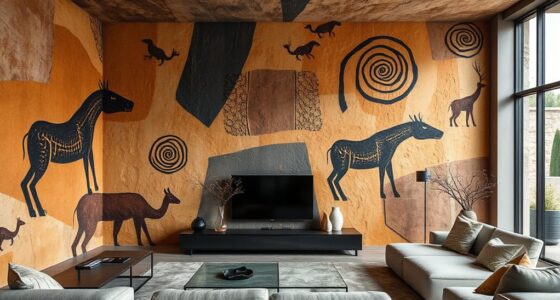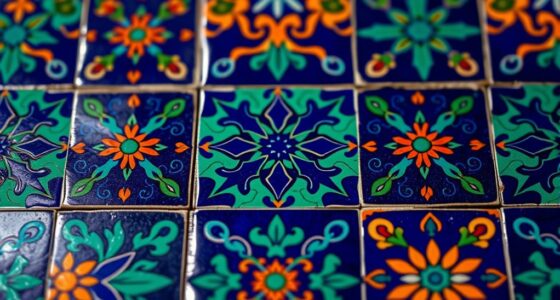Art Nouveau and Art Deco reflect two distinct eras and artistic visions. Art Nouveau, emerging around 1890, emphasizes organic, flowing forms inspired by nature, with intricate craftsmanship. Art Deco, from the 1920s-30s, features bold geometric shapes, sleek lines, and modern materials symbolizing progress. While Art Nouveau seeks harmony with nature, Art Deco celebrates technological advancements. Exploring their origins, motifs, and cultural impacts reveals how these styles continue to influence design today. You’ll uncover more about their fascinating differences and enduring legacies.
Key Takeaways
- Art Nouveau (1890-1910) emphasized organic, flowing forms inspired by nature, while Art Deco (1920s-1930s) focused on bold geometric and stylized motifs.
- Art Nouveau aimed for harmony with nature and craftsmanship; Art Deco celebrated modernity, technological progress, and streamlined design.
- Art Nouveau’s visual language features sinuous lines and floral motifs; Art Deco employs symmetrical, geometric patterns and stylized abstract forms.
- Art Nouveau originated in France and Belgium, emphasizing artisanal skills; Art Deco was influenced by industrial materials and global modernist trends.
- Both styles significantly impacted global decorative arts, but Art Nouveau prioritized natural beauty and craftsmanship, whereas Art Deco embodied progress and modern luxury.
Origins and Historical Context
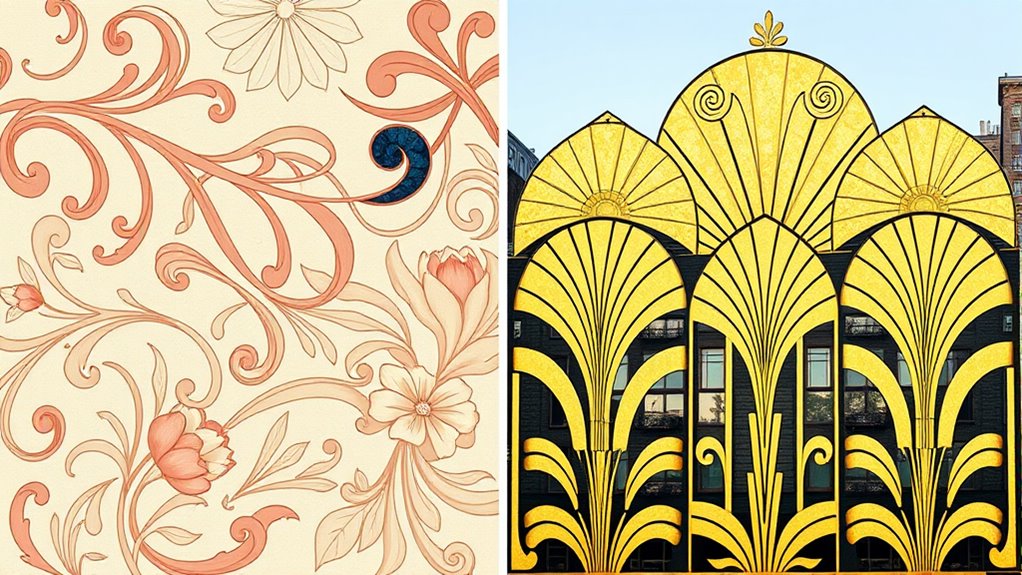
Art Nouveau and Art Deco emerged during distinct periods, shaped by different social and cultural influences. The industrial revolution sparked rapid technological advancements, transforming industries and daily life. Art Nouveau, flourishing around 1890 to 1910, reacted to industrialization by emphasizing craftsmanship and organic forms, aiming to bring beauty into everyday objects. In contrast, Art Deco arose in the 1920s and 1930s, reflecting the optimism and speed of modern technological progress. It embraced sleek lines, geometric shapes, and luxury, often showcasing new materials made possible by industrial innovations. You can see how these movements responded differently to technological change: Art Nouveau sought harmony with nature and craftsmanship, while Art Deco celebrated progress, innovation, and the machine age.
Key Artistic Features and Motifs
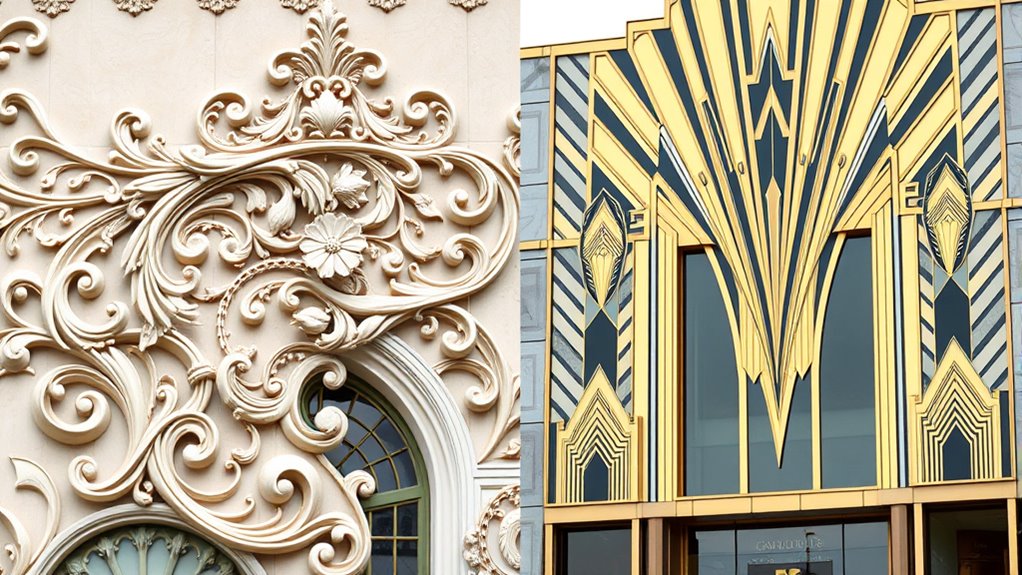
You’ll notice that Art Nouveau emphasizes flowing, organic forms and intricate floral motifs, creating a sense of natural beauty. In contrast, Art Deco favors bold, geometric lines and striking patterns that convey modernity and strength. Both styles use color and line to make powerful visual statements, but in very different ways. Additionally, understanding the visual language of each style helps to appreciate how they evoke different emotional responses and cultural ideals.
Organic Vs Geometric Forms
While both Art Nouveau and Art Deco showcase distinctive visual identities, their use of forms and motifs sets them apart vividly. Art Nouveau emphasizes organic forms, often inspired by floral patterns and flowing lines that mimic nature’s curves. You’ll notice its sinuous, asymmetrical shapes that evoke movement and natural growth. In contrast, Art Deco favors geometric symmetry, with clean lines, sharp angles, and stylized motifs. You’ll see bold, repetitive patterns that create a sense of order and modernity. Art Deco’s emphasis on geometric forms reflects a fascination with progress and machine-age aesthetics. This fundamental difference shapes their visual languages: one rooted in natural, flowing shapes, the other in precise, structured geometry. Each style communicates its era’s unique artistic vision through these contrasting forms. Additionally, the artistic features of each movement influence their impact on contemporary design and architecture.
Floral and Natural Motifs
How do floral and natural motifs define the visual language of Art Nouveau and Art Deco? In Art Nouveau, you’ll notice intricate botanical patterns that flow organically, emphasizing floral symbolism to evoke harmony with nature. These motifs often feature stylized flowers, vines, and leaves that seem to grow freely across surfaces, creating a sense of movement and fluidity. Conversely, Art Deco incorporates more streamlined, stylized floral designs, simplifying natural forms into geometric or symmetrical patterns. These botanical patterns serve to add elegance and sophistication, often framing architectural elements or decorative objects. While both styles celebrate nature, Art Nouveau’s motifs are lush and ornate, whereas Art Deco’s are sleek and abstract, reflecting their contrasting artistic philosophies. Additionally, the use of natural materials and rustic decor in design highlights the appreciation for organic elements characteristic of these styles.
Bold Color and Lines
Both Art Nouveau and Art Deco use bold colors and lines to create striking visual impressions, but they do so in distinctly different ways. In Art Nouveau, you’ll notice the use of rich, symbolic colors that convey emotion and meaning through color symbolism, often inspired by nature. The lines here are flowing and organic, emphasizing curves and intricate details that mimic natural forms. Conversely, Art Deco favors strong, vibrant colors like gold, black, and jewel tones, emphasizing luxury and modernity. The lines are sharper, more geometric, and streamlined, highlighting line emphasis to create a sense of movement and rhythm. These contrasting approaches make each style visually distinct—one with fluid, symbolic colors and organic lines, the other with bold, metallic hues and precise geometric lines. Additionally, each style offers decorative techniques that contribute to their unique aesthetic identities.
Influences and Inspirations
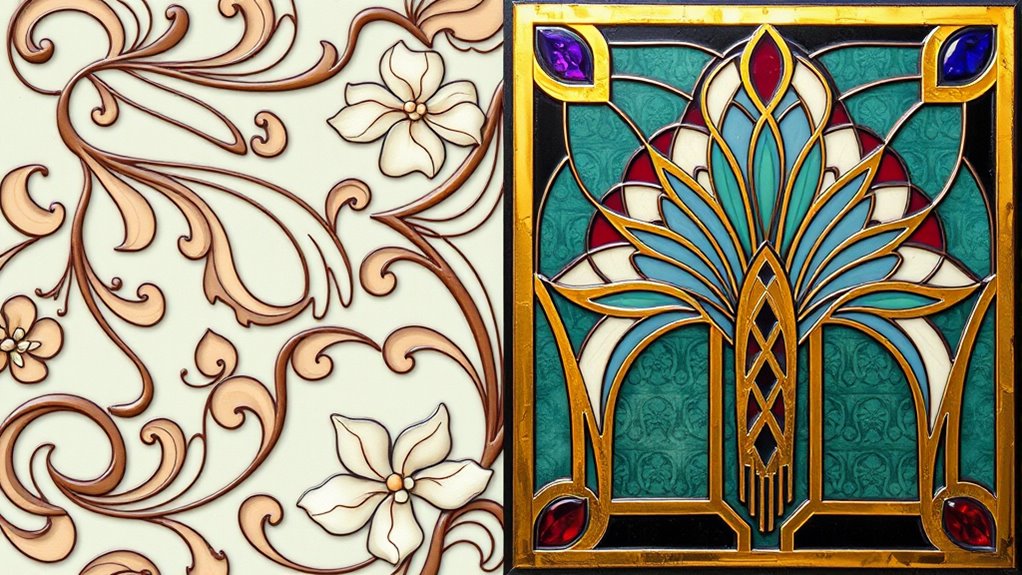
Art Nouveau drew inspiration from the natural world, incorporating flowing lines, organic shapes, and motifs inspired by plants, flowers, and insects. It also embraced mythological references, drawing on legends and symbols to evoke a sense of wonder and spirituality. Additionally, technological influences played a role, as innovations like new manufacturing techniques allowed for intricate designs and detailed craftsmanship. This movement sought harmony between nature and human creativity, blending artistic expression with emerging technologies and cultural stories. The use of manufacturing techniques enabled artisans to realize complex and delicate designs that were previously impossible. Your understanding of Art Nouveau’s influences reveals its deep connection to both the organic environment and mythic symbolism. These elements combined to create a style that feels both timeless and innovative, reflecting a desire to unify art, nature, and modern progress.
Prominent Architects and Designers
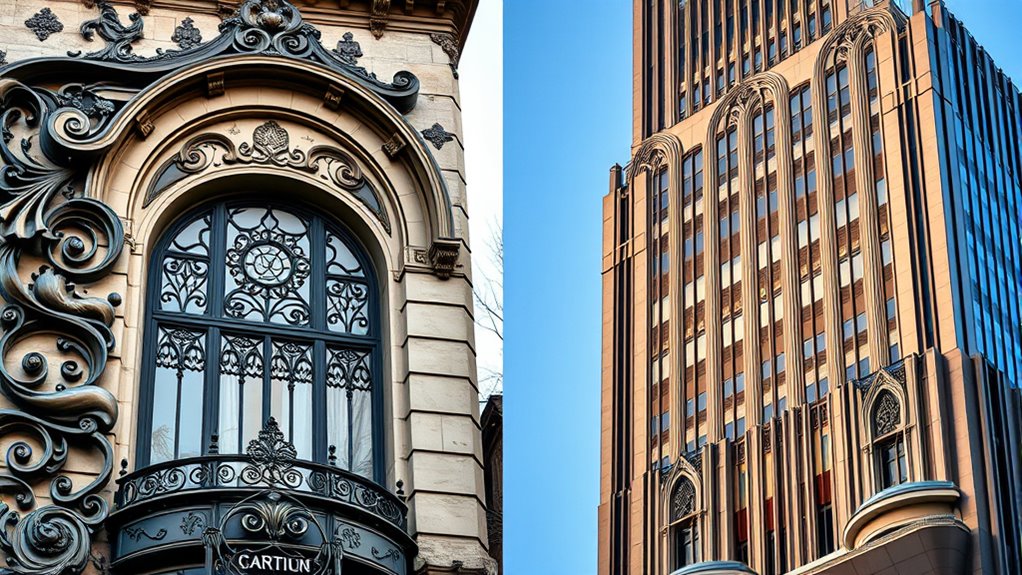
Leading designers and architects of the Art Nouveau movement brought its organic and decorative qualities to life through innovative visions and craftsmanship. They emphasized intricate stained glass, often featuring flowing, natural motifs that transformed spaces with vibrant colors and light. Prominent figures like Hector Guimard and Antoni Gaudí revolutionized interior design by incorporating curvilinear forms and nature-inspired details, creating immersive environments. Their work prioritized harmony between architecture and decorative arts, blending functionality with artistic expression. You can see their influence in furniture, lighting, and decorative elements that evoke a sense of unity and elegance. These designers challenged traditional styles, making the interior spaces not just functional but also mesmerizing works of art rooted in nature’s beauty.
Architectural Styles and Examples
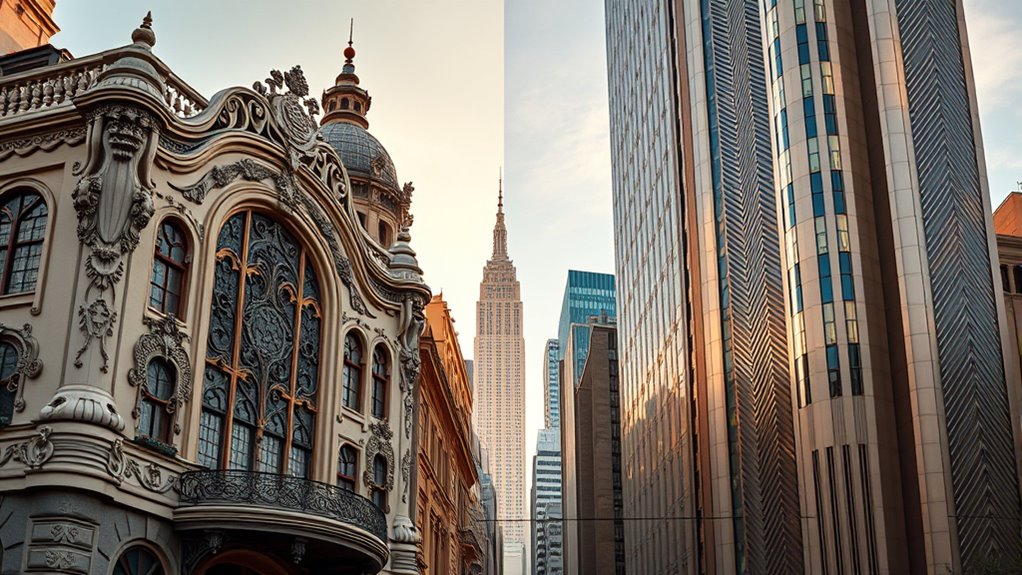
Art Nouveau and Art Deco each brought distinctive architectural styles that define their respective eras. Art Nouveau emphasizes organic shapes, flowing lines, and decorative glass ceilings that create a sense of harmony. Its buildings often feature intricate ironwork and curved forms, blending architecture with art. Art Deco, however, reflects modernity with geometric patterns, sleek lines, and bold motifs. Its designs prioritize luxury and progress, often incorporating glass ceilings that maximize natural light. When considering urban planning, Art Nouveau integrates buildings into their environments with organic shapes, while Art Deco favors monumental structures that symbolize progress. Here are some key examples:
- *Hôtel Tassel in Brussels (Art Nouveau)*
- *Empire State Building in New York (Art Deco)*
- *Palais de Chaillot in Paris (Art Deco)*. Additionally, the integration of these styles into urban planning demonstrates how architectural styles influence city landscapes and cultural identities.
Decorative Arts and Craftsmanship

Both Art Nouveau and Art Deco placed a strong emphasis on decorative arts and craftsmanship, showcasing their distinct artistic philosophies. Art Nouveau highlights materials innovation by using organic forms, flowing lines, and natural motifs, often integrating glass, ceramics, and wrought iron. Its craftsmanship emphasizes artisanal skills, celebrating intricate detailing and handcrafted quality. In contrast, Art Deco adopts a more streamlined approach, utilizing new materials like chrome, aluminum, and Bakelite to create sleek, geometric designs. The craftsmanship focuses on precision and mass production, reflecting industrial progress. Both movements incorporate cultural symbolism—Art Nouveau draws inspiration from nature and mythology, while Art Deco embraces modernity and progress, embedding cultural themes into their decorative arts. This approach defines their unique identities and artistic legacies. Additionally, the industrialization of manufacturing during the Art Deco period allowed for greater consistency and efficiency in creating decorative objects.
Cultural and Social Significance
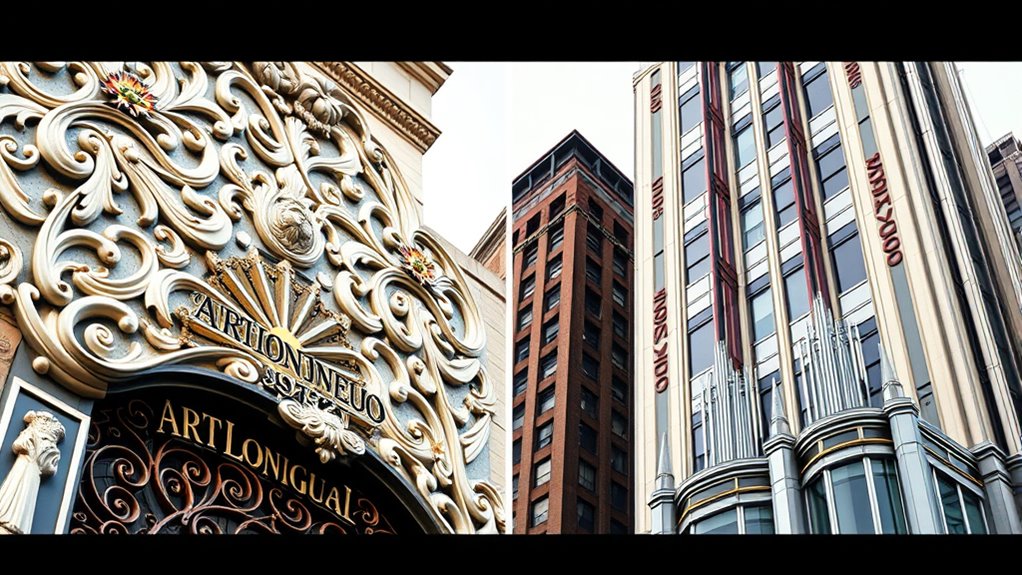
The distinctive craftsmanship and decorative elements of Art Nouveau and Art Deco reflect their broader cultural and social roles. Art Nouveau emerged during a time of sociopolitical influences emphasizing individualism and nature, often challenging traditional gender roles by highlighting femininity and organic forms. Conversely, Art Deco signifies modernity, progress, and optimism, aligning with industrial growth and shifting societal norms. Your understanding of these movements reveals how they influenced societal perceptions: – Art Nouveau’s focus on craftsmanship challenged traditional gender expectations, empowering women as creators. – Art Deco’s geometric designs symbolized technological progress and a desire for social equality. – Both styles mirror their eras’ sociopolitical influences, shaping cultural identity and societal values. Additionally, the emphasis on craftsmanship in Art Nouveau played a role in elevating decorative arts to fine art status, further impacting cultural perceptions.
Spread and Global Adoption
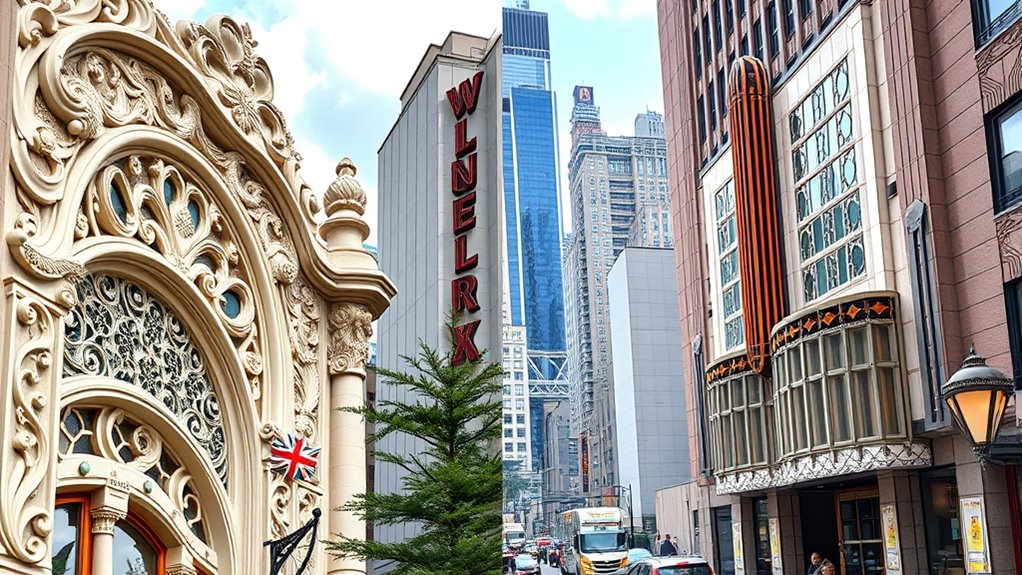
While Art Nouveau originated in France and Belgium, its intricate organic forms quickly captivated designers across Europe and beyond. This cultural diffusion fueled its spread into countries like the United States and Japan, where local artists adapted its motifs to regional aesthetics. The global influence of Art Nouveau can be seen in architecture, decorative arts, and design, inspiring iconic structures and objects worldwide. As artisans embraced its emphasis on craftsmanship and natural themes, the style transcended borders, shaping visual culture across continents. Its widespread adoption reflected a desire to break free from traditional styles and embrace innovation. Additionally, the style’s cross-cultural exchange facilitated the blending of diverse artistic traditions, enriching its visual vocabulary. Overall, the international reach of Art Nouveau underscores its significance as a movement that fostered cross-cultural exchange and left a lasting mark on global design history.
Legacy and Continued Impact
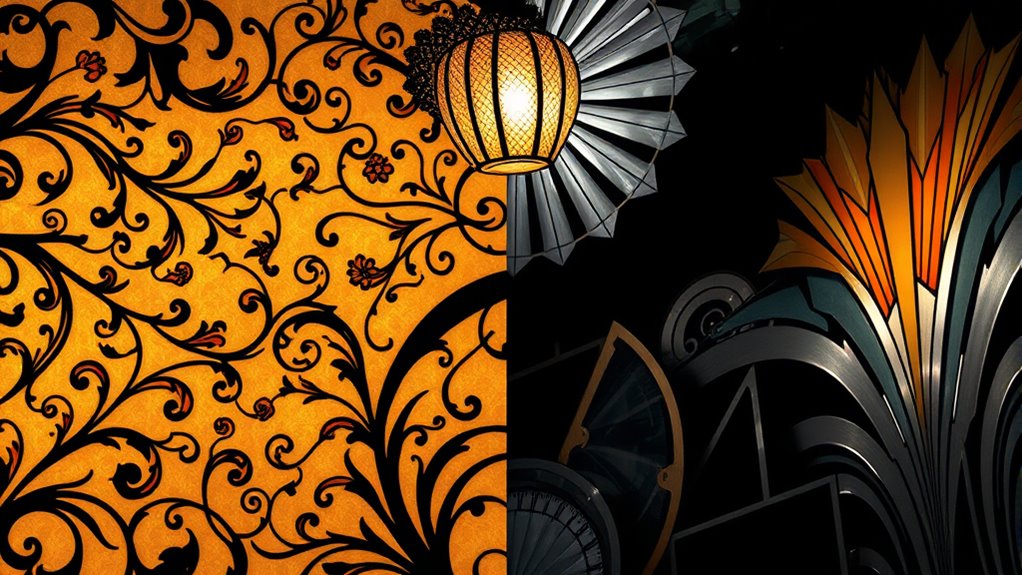
Have you ever wondered how Art Nouveau continues to influence design today? Its legacy lives on through a modern revival that emphasizes organic forms, intricate details, and decorative arts. This style’s influence remains evident in contemporary architecture, fashion, and graphic design, blending vintage elegance with modern aesthetics. The movement’s emphasis on craftsmanship also inspires current artisans and designers to prioritize quality and artistic expression. Art Nouveau’s legacy shapes today’s appreciation for art-inspired designs, creating a bridge between past and present. Its enduring impact highlights how innovative ideas can evolve, inspiring new generations to explore beauty and functionality together. The revitalization of craftsmanship and artisanal techniques in contemporary projects demonstrates how the movement’s focus on meticulous detail continues to resonate today.
Frequently Asked Questions
How Did Art Nouveau Influence Modern Design Movements?
You can see Art Nouveau’s influence in modern design through its use of stained glass techniques and botanical motifs. It encourages you to embrace organic shapes and intricate details, inspiring contemporary artists to incorporate natural elements and craftsmanship into their work. By blending artistic styles with functional design, Art Nouveau has shaped today’s aesthetic, emphasizing beauty, nature, and craftsmanship in ways that remain relevant and innovative.
What Are the Main Differences in Color Palettes Between the Two Styles?
Imagine stepping into a world where colors tell stories—Art Nouveau’s palette is like a vintage Instagram filter, featuring soft, harmonious shades inspired by nature. In contrast, Art Deco’s bold, metallic hues scream luxury and glamour, emphasizing striking contrasts. Your eye notices how color harmony and palette symbolism define each style’s mood: organic and gentle versus sleek and opulent, making each visual language uniquely mesmerizing.
Which Regions Favored Art Deco Over Art Nouveau Historically?
You’ll notice that regions like the United States and France favored Art Deco over Art Nouveau historically, driven by their regional aesthetics and economic growth. In the 1920s and 1930s, Art Deco’s sleek, geometric designs aligned with modernity and progress, appealing to urban centers seeking a futuristic look. Conversely, Art Nouveau was more popular in parts of Europe, emphasizing organic forms and decorative art styles, reflecting regional tastes and cultural preferences.
How Did Technological Advances Shape Each Style’s Development?
Imagine a painter’s palette bursting with colors—technological innovation acts as that vibrant brushstroke, shaping each style’s development. For Art Nouveau, advances in manufacturing processes allowed for intricate, flowing designs inspired by nature. In contrast, Art Deco thrived on sleek, geometric forms driven by mass production techniques, making luxury accessible. These technological strides fueled creativity, turning artistic visions into tangible, mesmerizing realities that defined each era’s aesthetic.
Are There Contemporary Artists Still Inspired by These Styles?
Yes, contemporary artists are still inspired by Art Nouveau and Art Deco. You’ll see modern artist influences in their work, blending these classic styles with new techniques. This creates a contemporary style revival that honors the elegance and innovation of the past. Artists often incorporate flowing lines and decorative details from Art Nouveau or geometric patterns from Art Deco, enriching today’s design with historical depth and artistic diversity.
Conclusion
Think of Art Nouveau and Art Deco as two distinct melodies in a grand symphony of design—each with its unique rhythm and harmony. Art Nouveau flows like a graceful river, emphasizing organic forms and craftsmanship, while Art Deco strikes like a bold drumbeat, celebrating glamour and modernity. Together, they compose a mesmerizing duet that continues to inspire and shape the world of art and architecture, reminding us of the timeless dance between nature and innovation.




